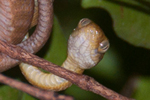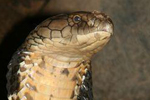
New snail-eating snake from Panama: Sibon noalamina. Non-venomous snail-eating snakes sport bright colors to mimic poisonous snakes as a defense. Photo © Sebastian Lotzkat.
While scientists increasingly name new species after celebrities in order to gain much-needed attention for the world’s vanishing biodiversity, researchers describing a new snake species from Panama have taken a different route. Dubbing the new serpent, Sibon noalamina (‘no to the mine!’ in Spanish), the scientists are hoping the multicolored snake’s unusual name will draw attention to mining and deforestation issues in Panama’s remote Tabasará mountains.
“[‘No to the mine’] is used by members of the indigenous Ngöbe communities living in the Serranía de Tabasará in the course of their protests against mining interests aiming to exploit their territory, especially around Cerro Colorado,” the scientists explain in a paper describing the species in Zootaxa. “The specific name is given in recognition and support of the Ngöbe’s struggle to protect their territory and environment, which is home to the new species described herein and many others, from profit-driven destructive interventions.”
Discovered in the region’s montane rainforests, the 21-inch long new species is a variety of snail-eating snake, which also devours slugs, earthworms, and amphibian eggs. While it closely resembles another snail-eating species, Sibon noalamina has unique scalation and other differences that make it a distinct species.
However, high deforestation rates and the impending threat of ore and copper mining in the region puts this snake at risk, warn it’s discoverers who believe the species may only reside in the Tabasará mountains. In addition, the ‘no-to-the-mine snail-eating snake’ is not the only species at risk.
“Although comparatively little fieldwork has been carried out in this mountain chain,” the researchers note, at least five reptiles and two frogs are currently believed to be endemic to the Tabasará mountains. In addition, the region “shelter(s) surviving populations of various endangered amphibian species, some of which have not been detected elsewhere since the outbreak of chytridiomycosis in Lower Central America.” The amphibian disease, chytridiomycosis, has decimated populations across Central America, pushing a number of species to extinction.
But the Tabasará mountains remain under heavy pressure: over one-fifth of the region’s forests were lost in the 1990s alone. Meanwhile, little of the area is currently protected.
“Without the establishment of protected areas and the development of sustainable alternatives to large-scale forest clearance, these unique ecosystems will vanish in the foreseeable future,” lead author Sebastien Lotzkat with the Senckenberg Research Institute says in a press statement, “and with them, the congenial colubrid, its crawling and croaking fellows, and the livelihoods of the indigenous population.”

Graffiti opposing mining in the Tabasará mountains. Photo © Sebastian Lotzkat.

Juvenile Sibon noalamina. Photo © Sebastian Lotzkat.

Male Sibon noalamina. Photo © Sebastian Lotzkat.
CITATION: Sebastian Lotzkat, Andreas Hertz, Gunther Kohler. A new species of Sibon (Squamata: Colubroidea: Dipsadidae) from the
Cordillera Central of western Panama, with comments on other species
of the genus in the area. Zootaxa. 3485: 26–40 (2012).
Related articles
Arachnopocalypse: with birds away, the spiders play in Guam

(09/17/2012) The island of Guam is drowning in spiders. New research in the open-access journal PLOS ONE has found that in the wet season, Guam’s arachnid population booms to around 40 times higher than adjacent islands. Scientists say this is because Guam, a U.S. territory in the Pacific, has lost its insect-eating forest birds. Guam’s forests were once rich in birdlife until the invasion of non-native brown tree snake (Boiga irregularis) in the 1940s decimated biodiverse bird communities. Now, the island is not only overrun with snakes, but spiders too.
Massive snake found in Florida (photos)
(08/14/2012) Researchers in Florida have documented the biggest snake ever found in Florida. But the snake is an invader — it’s not native.
‘Beautiful’ new snake discovered in Cambodia (photo)
(07/16/2012) Scientists have discovered a new snake species in the biodiverse rainforests of the Cardamom Mountains, reports Fauna & Flora International (FFI). The new reddish-hued serpent has been named after its country of origin by native herpetologist Neang Thy: the Cambodian kukri (Oligodon kampucheaensis).
Meet the world’s rarest snake: only 18 left
-(Large).150.jpg)
(07/10/2012) It’s slithery, brown, and doesn’t mind being picked up: meet the Saint Lucia racer (Liophis ornatus), which holds the dubious honor of being the world’s most endangered snake. A five month extensive survey found just 18 animals on a small islet off of the Caribbean Island of Saint Lucia. The snake had once been abundant on Saint Lucia, as well, but was decimated by invasive mongooses. For nearly 40 years the snake was thought to be extinct until in 1973 a single snake was found on the Maria Major Island, a 12-hectare (30 acre) protected islet, a mile off the coast of Saint Lucia (see map below).
96 percent of the world’s species remain unevaluated by the Red List

(06/28/2012) Nearly 250 species have been added to the threatened categories—i.e. Vulnerable, Endangered, and Critically Endangered—in this year’s update of the International Union for Conservation of Nature’s (IUCN) Red List. The 247 additions—including sixty bird species—pushes the number of threatened species globally perilously close to 20,000. However to date the Red List has only assessed 4 percent of the world’s known species; for the other 96 percent, scientists simply don’t know how they are faring.